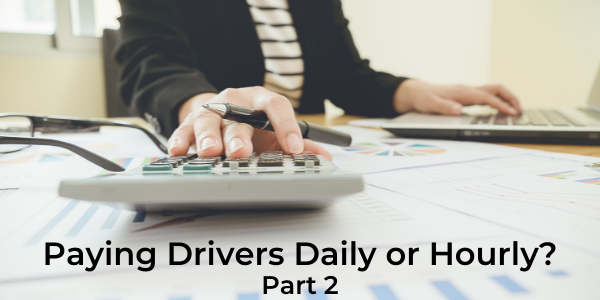
This post is the second in a two-part series.
In my last blog post, I shared that people often ask me, “Should I pay my drivers by the day or by the hour?” My answer is based on comparing both methods, and I'll tell you why I recommend paying drivers by the hour.
Paying by the day is still most common because it’s a holdover from when delivery volume was consistent and only 5-days per work week.
As a result of adding residential service and e-commerce, package volume swings now vary widely on a daily basis. Paying drivers by the day has made business owner profitability more challenging.
Current Trends
Residential deliveries, e-commerce, and seven days operations permanently changed the FXG last mile delivery business. And future changes may ultimately force operators to take a retail or hospitality type approach, i.e., matching labor to revenue volume.
Since eTruckBiz processes payroll, we receive a real-life view of pay ranges being used in last mile delivery.
For hourly pay, many drivers are paid $15/hour while more seasoned drivers are paid around $21/hour, with the average being in the $18.75-19.00/hour range.
In regards to a daily rate, we see a broader range. Pay starts at $130/day up to $225/day and commonly we see it around $180/day.
Side Note: It is important to remember that local geographic markets strongly influence compensation levels.
Many CSP’s are not fully aware of their own average wage rates for drivers. You can calculate yours by dividing a Pay Period's Total Driver Pay by the same Pay Period's Total On Duty Hours.
It should also be noted that regardless of the method (hourly or daily), Contractors routinely underestimate their paid average hourly rate. Usually, it's underestimated by $3.00-$4.00 per hour.
How Does This Help Me?
Perhaps now is the time to ask yourself how you're measuring your performance, and if improvements are needed, how to make simple changes.
First thing to understand is that there is a “magic” number to aim for in this business regarding your labor dollars spent vs your revenue generated. A healthy P&D operation typically aims for driver labor not to exceed 45% of total revenue.
You can calculate your percentage as follows:
.png?width=197&name=RedOne%20Week%20of%20Total%20Driver%20Pay%20(not%20including%20management%20-%20unless%20they%20drive).png)
The result will be your labor cost as a percent of revenue.
For example:
Your labor as a percent of revenue equals 62.5% ($5000/$8000), which is not sustainable in the long run.
How Do I Calculate Profitability?
Let’s carry that a step further. Have you thought about the amount of revenue a route produces vs a driver’s pay?
It’s determined by knowing your revenue per stop, the number of stops on a route, and driver pay.
For example, if a company pays a driver $100/day and makes $2 revenue per stop, how many stops must that driver make to be at 45% of the revenue?
The answer is that route must generate revenues of $222 in order to achieve 45% of the revenue.
If a company is paid $2/stop, dividing that amount into the $222/day tells us this route needs at least 111 stops. Otherwise, the driver is overpaid.
You can take this same thought even further. If those numbers (driver pay of $100/day and $2/revenue per stop) are the average for your business, you can calculate the number of stops needed to ensure total drivers’ pay is 45% of your overall revenue.
In the above example, you should average 111 stops per dispatch over a week for the entire operation to reach your 45% number.
If you're not achieving that every day, then paying drivers by the hour is even more important. If you can’t increase your revenue on a route by adding more stops, then logically you need to reduce your costs.
If you are paying by the day, reducing the driver's cost is difficult. You can more easily adjust the percentages by paying hourly.
Pro Tip: Paying hourly also eliminates the, “I am working longer, so pay me more,” complaint.
Are you wanting to know how your drivers are performing financially on all your routes?
Is There A Tool I Can Use?
Our Optix App is a tool that provides an insightful daily look at how routes are performing financially.
Below are 2 screenshots showing a real route in the Optix App (personal info has been blurred out on purpose). You’ll see why it lost money.
The data highlighted in the red boxes shows this route was dispatched with 16 stops. The driver's last stop should be at 11:27 AM. You’ll also see a 100% service level for the day, and 14.7 SPH (stops per hour).
If we look at the next screenshot from the route’s financial performance section (below), the red boxes show the route’s financial performance.
In the far-right red box below, we see the driver is paid $155 per day. In the center bottom red box, we see that this route will generate $72.34 of revenue.
The top center red box tells us that the driver is 100% complete with this route and that by running this route there's a net loss of $82.66 today ($155 driver pay - $72.34 total revenue).
The bottom right red box lets us know that the driver’s labor as a percent of revenue was 214.27% for the day, obviously missing the 45% goal.
The Optix App highlights where routes are under dispatched, plus indicates the drivers who should be given more stops.
In the example above, the driver should have been given 76 stops to merit their daily pay rate of $155.
How Should I Improve Profitability?
The first option is eliminating underperforming routes by finding other routes to take/absorb stops. If that’s not an option, then paying the driver by the hour would improve the financial performance.
Remember, the driver had only 16 stops at 14.7 Stops Per Hour. It is a real-world example where the driver shouldn't have been dispatched.
This is part of the reason drivers may over inflate their monetary value in the business. The real-life example above shows a driver was paid $155 for about 2 hours of work.
Your Key Takeaways Are:
- Dispatch your routes at maximum stop capacity. Otherwise, routes dispatched with less than capacity should be paid at an hourly rate in order to maintain a 45% labor rate. Pro Tip: Strong DRO plans that have flexibility designed in them is the first step in solving this issue.
- As a CSP, you should know the average stops/dispatch in order to maintain your labor at 45% of revenue.
- Identify which routes in your organization are financially viable and which ones are not. We can offer assistance if you're interested..
- Paying by the day creates payroll audit risk if a vehicle in your fleet is <10,001 lbs. GVW.
- Paying by the day creates exposure to non-compliance with state overtime laws and rules.
- You risk reimbursing FedEx if any of your drivers successfully take part in an awarded judgement in which you cannot produce evidence that they were paid overtime accurately.
Hopefully, this has given you some information on why I recommend that hourly pay is a key component to long-term success in the FedEx Ground environment. As always, eTruckBiz has tools and the experience to help you navigate and manage your business successfully.
